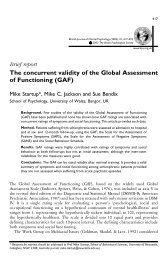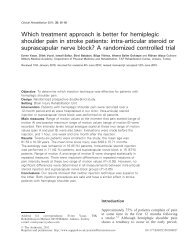Predictive validity of the Hendrich fall risk model II in an acute ...
Predictive validity of the Hendrich fall risk model II in an acute ...
Predictive validity of the Hendrich fall risk model II in an acute ...
Create successful ePaper yourself
Turn your PDF publications into a flip-book with our unique Google optimized e-Paper software.
472<br />
Table 1<br />
Frequency <strong>of</strong> <strong>risk</strong> factors on <strong>the</strong> studied population.<br />
Items N %<br />
Vertigo 87 49<br />
Incont<strong>in</strong>ence 86 48<br />
Depression 82 46<br />
Sex (male) 74 41<br />
Confusion 58 32<br />
Benzodiazep<strong>in</strong>es 50 28<br />
Get up <strong>an</strong>d go (score 3) 36 20<br />
Antiepileptics 13 0.7<br />
Table 2<br />
Psychometric properties <strong>of</strong> HFRM <strong>II</strong>.<br />
Values CI 95%<br />
Sensitivity 0.86 0.67–1.04<br />
Specificity 0.43 0.34–0.51<br />
PPV 0.11 0.051–0.17<br />
NPV 0.97 0.94–1.01<br />
studies that reported <strong>the</strong>se factors more prevalent <strong>in</strong> <strong>the</strong><br />
hospitalized elderly population (Oliver et al., 2004).<br />
Of 179 patients <strong>in</strong>cluded <strong>in</strong> <strong>the</strong> study, 106 were<br />
classified at <strong>risk</strong> (HFRM <strong>II</strong> 5) <strong>an</strong>d 73 not at <strong>risk</strong> <strong>of</strong> <strong>fall</strong><strong>in</strong>g.<br />
Of 106 patients classified at <strong>risk</strong> 12 fell (11%), <strong>an</strong>d <strong>of</strong> 73<br />
classified not at <strong>risk</strong> 2 older people fell (2.7%).<br />
87.5% patients fell with<strong>in</strong> <strong>the</strong> first 10 days <strong>of</strong><br />
hospitalization, <strong>in</strong>dicat<strong>in</strong>g that <strong>the</strong> elderly recover<strong>in</strong>g from<br />
<strong>acute</strong> illnesses are more frail <strong>an</strong>d subject to <strong>fall</strong>-prone <strong>in</strong><br />
<strong>the</strong> first days <strong>of</strong> <strong>the</strong> hospitalization.<br />
The me<strong>an</strong> age <strong>of</strong> <strong>the</strong> <strong>fall</strong>ers was 81 (SD 8.5); <strong>the</strong> ratio <strong>of</strong><br />
males <strong>an</strong>d females was equal <strong>in</strong> <strong>the</strong> <strong>fall</strong>ers (7 females <strong>an</strong>d 7<br />
males) with a quite similar me<strong>an</strong> age (males 81.14 <strong>an</strong>d<br />
females 80.7).<br />
The sensitivity <strong>of</strong> HFRM <strong>II</strong> was 86% <strong>an</strong>d <strong>the</strong> specificity<br />
43%. The positive predictive value was 11% identify<strong>in</strong>g 12<br />
patients that fell on 106 at <strong>risk</strong> patients. The negative<br />
predictive value was 97.26% <strong>an</strong>d allowed to identify 71/73<br />
<strong>of</strong> <strong>the</strong> patients that did not <strong>fall</strong>. The 95% confidence<br />
<strong>in</strong>tervals showed a narrower r<strong>an</strong>ge for <strong>the</strong> specificity<br />
(0.34–0.51) <strong>an</strong>d a broader r<strong>an</strong>ge for sensitivity (0.67–1.04).<br />
In Table 2 <strong>the</strong> psychometric properties <strong>of</strong> <strong>the</strong> <strong>Hendrich</strong> <strong>II</strong><br />
<strong>model</strong> are described <strong>in</strong> detail.<br />
The <strong>an</strong>alysis <strong>of</strong> ROC curve has been carried out to f<strong>in</strong>d <strong>the</strong><br />
best cut<strong>of</strong>f <strong>an</strong>d best sensitivity <strong>an</strong>d specificity values. The<br />
best cut<strong>of</strong>f po<strong>in</strong>t was found for values equal or higher th<strong>an</strong> 5,<br />
comparable to that <strong>in</strong>dicated <strong>in</strong> <strong>the</strong> development study<br />
(<strong>Hendrich</strong> et al., 2003) <strong>an</strong>d <strong>in</strong> Kim’s study (Kim et al., 2007).<br />
The area under <strong>the</strong> curve (AUC) was 0.71 (95% CI 0.60–<br />
0.85), show<strong>in</strong>g a moderate discrim<strong>in</strong>at<strong>in</strong>g power <strong>of</strong> <strong>the</strong><br />
tool (Fig. 1), similarly to <strong>the</strong> values found <strong>in</strong> Kim et al.’s<br />
study (0.73, 95% CI 67–80).<br />
3.5. Risk factors <strong>in</strong> hospitalized elderly<br />
To evaluate <strong>the</strong> <strong>risk</strong> factors that affected <strong>the</strong> <strong>fall</strong>s <strong>in</strong> our<br />
population we calculated <strong>the</strong> odds ratio for each <strong>risk</strong> factor<br />
(Table 3).<br />
The only two <strong>risk</strong> factors that were signific<strong>an</strong>tly related<br />
to <strong>fall</strong>s <strong>in</strong> our study were confusion (OR: 4.26; 95% CI 1.35–<br />
D. Ivziku et al. / International Journal <strong>of</strong> Nurs<strong>in</strong>g Studies 48 (2011) 468–474<br />
13.36) <strong>an</strong>d depression (OR: 3.22; 95% CI 0.97–10.71),<br />
consistently with weight attributed to <strong>the</strong>se <strong>risk</strong> factors <strong>in</strong><br />
<strong>the</strong> tool: <strong>in</strong> fact <strong>Hendrich</strong> recognized a score <strong>of</strong> 4 to <strong>the</strong><br />
confusion <strong>an</strong>d <strong>of</strong> 2 to <strong>the</strong> depression.<br />
4. Discussion<br />
In <strong>the</strong> present study <strong>the</strong> predictive properties as well as<br />
reliability <strong>an</strong>d feasibility <strong>of</strong> <strong>the</strong> HFRM <strong>II</strong> were assessed <strong>in</strong> a<br />
geriatric unit <strong>of</strong> a Teach<strong>in</strong>g Hospital.<br />
Our results showed that <strong>the</strong> time needed to complete<br />
<strong>the</strong> HFRM <strong>II</strong> was about 1 m<strong>in</strong>, as <strong>in</strong>dicated by <strong>Hendrich</strong><br />
(2007). The nurses found it easy <strong>an</strong>d quick to use because<br />
no additional data <strong>an</strong>d time were needed to assess <strong>the</strong> <strong>risk</strong><br />
at <strong>the</strong> patients admission: <strong>the</strong> tool could be compiled us<strong>in</strong>g<br />
<strong>the</strong> data collected at <strong>the</strong> moment <strong>of</strong> admission <strong>in</strong> <strong>the</strong><br />
nurs<strong>in</strong>g assessment record <strong>an</strong>d observ<strong>in</strong>g <strong>the</strong> patient<br />
movements <strong>in</strong> <strong>the</strong> room, not <strong>in</strong>creas<strong>in</strong>g <strong>the</strong> nurs<strong>in</strong>g<br />
workload, already heavy <strong>in</strong> geriatric units, <strong>an</strong>d not add<strong>in</strong>g<br />
burden to <strong>the</strong> patient. In <strong>acute</strong> care hospitals <strong>the</strong>se factors<br />
are import<strong>an</strong>t if we w<strong>an</strong>t that <strong>fall</strong> <strong>risk</strong> assessment tools be<br />
extensively used <strong>in</strong> cl<strong>in</strong>ical practice, as <strong>the</strong> time dedicated<br />
to <strong>the</strong> patient assessment is affected by severity <strong>of</strong> patients<br />
admitted to <strong>the</strong> unit, number <strong>of</strong> nurses <strong>in</strong> staff <strong>an</strong>d<br />
complexity <strong>of</strong> nurs<strong>in</strong>g adm<strong>in</strong>istration duties, such as <strong>the</strong><br />
bulk <strong>of</strong> nurs<strong>in</strong>g records <strong>an</strong>d o<strong>the</strong>r documentations to write<br />
out (Dempsey, 2004).<br />
Compared to <strong>Hendrich</strong> et al. (2003) <strong>an</strong>d Kim studies<br />
(2007), we found higher values <strong>of</strong> sensitivity (86% vs. 74.9%<br />
<strong>an</strong>d 70%) <strong>an</strong>d lower values <strong>of</strong> specificity (43% vs. 73.9% <strong>an</strong>d<br />
61%) (Table 4).<br />
Table 3<br />
Relative <strong>risk</strong>s <strong>of</strong> <strong>the</strong> <strong>risk</strong> factors.<br />
Fig. 1. ROC curve.<br />
Risk factors OR CI P value<br />
Confusion 4.26 1.35–13.36 0.009<br />
Depression 3.22 0.97–10.71 0.03<br />
Incont<strong>in</strong>ence 1.08 0.36–3.24 0.21<br />
Vertigo 0.77 0.25–2.34 0.19<br />
Sex (male) 1.46 0.49–4.36 0.17<br />
Benzodiazep<strong>in</strong>es 1.03 0.30–3.46 0.23<br />
Antiepileptics 0.98 0.11–8.14 0.39<br />
Get up <strong>an</strong>d Go (score 3) 1.95 0.64–5.87 0.10
















